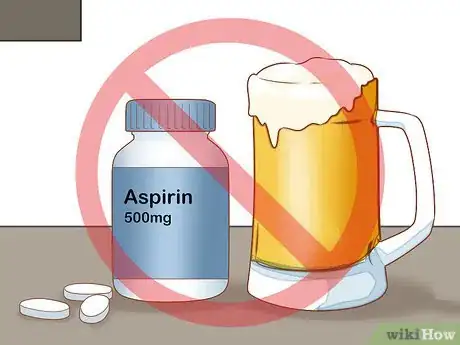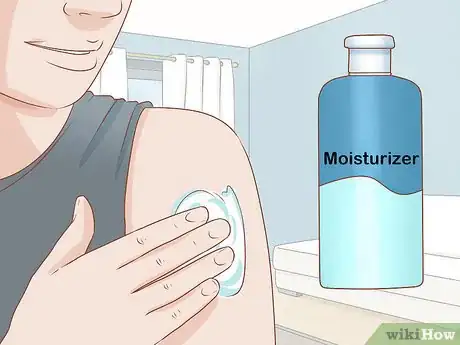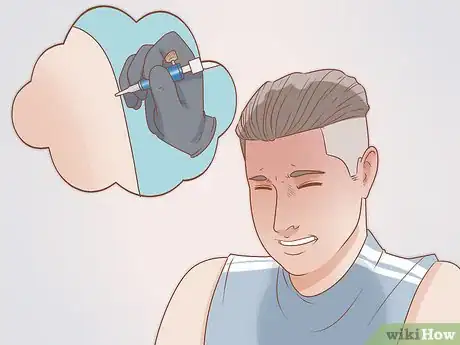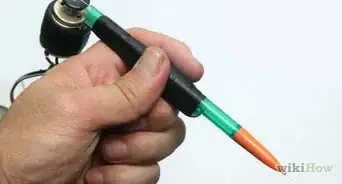This article was co-authored by Sasha Blue. Sasha Blue is a Professional Body Piercer and the Owner of 13 Bats Tattoo and Piercing Studio in the San Francisco Bay Area. Sasha has over 20 years of professional body piercing experience, starting with her apprenticeship in 1997. She is licensed with the County of San Francisco in California.
There are 8 references cited in this article, which can be found at the bottom of the page.
wikiHow marks an article as reader-approved once it receives enough positive feedback. In this case, 93% of readers who voted found the article helpful, earning it our reader-approved status.
This article has been viewed 291,602 times.
Getting a tattoo can be an exciting, as well as painful, experience. In order to assure that your tattoo experience is successful, and as painless as possible, there are some things you can do to prepare before hand. Making sure that you understand the process, that your body is properly prepared, and that you are happy with your design when you go in for your tattoo appointment.
Steps
Making Sure You are Physically Ready
-
1Hydrate yourself. Before you go to get tattooed, make sure that you are well hydrated. Drink lots of water for the 24 hours before your tattoo and avoid dehydrating yourself.
- How much water you need to drink to be well hydrated will depend on your specific body.[1] While some experts recommend eight glasses a day, your body may need more than that amount.[2]
- Well hydrated skin will be in better condition for getting tattooed. This means that the surface of the skin will take the ink easier, making tattoo application easier than it would be on dehydrated skin.
-
2Avoid thinning your blood. In order to limit your bleeding, you should avoid products that thin your blood for 24 hours before getting a tattoo. This means that you should avoid alcohol before getting a tattoo.[3]
- Also, avoid taking aspirin for the 24 hours before a tattoo. Aspirin is a blood thinner, so being on aspirin will make your tattoo bleed more.
Advertisement -
3Wear comfortable clothes. Depending on the size of the tattoo, you may be at the tattoo shop for several hours. You might as well be in a comfortable outfit while you are dealing with the discomfort of the tattoo process.[4]
- In addition, comfortable, loose clothing may be required in order for your tattoo artist to access the area where you are getting tattooed. If you are getting a tattoo in an area of your body that is usually covered up by clothing, make sure that you wear something to your appointment that will give the tattoo artist easy access to the area.
- For example, if you are getting a tattoo on your leg, consider wearing shorts or a skirt, so that the tattooist can easily get to the area. Similarly, if you are getting a tattoo on your upper arm, wear a sleeveless shirt.
-
4Eat before your appointment. It is important that you have enough food before your appointment so that you don't get light headed while getting a tattoo. The pain of a tattoo is bad enough, you don't want to add to it with lightheadedness or passing out into the mix.[5]
- Having low blood sugar can increase the physical reaction to a tattoo, making you more likely to pass out from the pain.
- Eating a solid meal before your appointment will give you the energy and stamina to withstand the pain of getting a tattoo. While it does not matter what you eat exactly, as long as it will give the sustenance you need to get through the appointment, eating a meal high in protein instead of sugar will sustain you longer.[6]
- If you are having an extremely long tattoo appointment, bring a quick snack, like a granola bar, with you. Your tattooist will be happy to take a quick break so that you can stay nourished.
-
5Prepare your skin. You do not need to do a lot to your skin before a tattoo. Just moisturize with your normal moisturizer for a week beforehand if you have dry skin to make sure that it is in good shape. Also, avoid getting a sunburn on the area you are getting tattooed. This means wearing sunscreen whenever you leave the house.
- While the area you are getting tattooed will need to be shaved, most tattoo artists do not want you to do it ahead of time. Instead, they will do it right before the tattoo to assure that any irritation does not interfere with the tattoo process.
Planning the Perfect Tattoo
-
1Think about a design. A tattoo design reflects a part of you and this part of you will be presented to the world every day. With this in mind, let your imagination go wild and think of a design that will be unique and will express to the world what you want it to. For example, this design could incorporate a symbol that has a special meaning to you, an animal that you have always loved, or it could use colors that signal an important period in your life.
- Have a design in mind before you make an appointment with a tattoo artist.
- When thinking about a design, you should also consider its size. For your first tattoo, you may want to get a small tattoo. This will allow you to understand the pain, and how you react to it over time, without the commitment of several hours in the tattoo chair.[7]
- Think of a design that you will be happy with in the future. While you can have a tattoo removed, it is a very, very painful process that can be expensive and time consuming.[8] Because of this, just think of them as permanent from the start and get a tattoo that you will be happy with in the future.
- You can either have your exact design planned out or you could rely on your tattoo artist to create a custom design for you. This is up to you.
-
2Consult with a tattoo artist. With your design in mind, find a tattoo artist that you want to work with. You can find one via word of mouth, for instance if your friend worked with a tattoo artist that they loved, or you can look online for tattoo artists in your area. Once you identify a tattoo artist, look at online reviews and look at their tattoo portfolio, either online or in their shop. If you like their style and their reputation, and you think that their style will translate well to your design idea, then book a consultation.[9]
- Most artists will draw out your tattoo design for you so that you can approve it at the beginning of your actual tattoo appointment. If there is anything about the design that you don't like, feel free to discuss it with the tattoo artist, to that they can make it exactly like you want it to be.
- Some tattoo artists are highly sought after and are not available for consultations in a timely manner. Instead, you will need to book an appointment with them months in advance. However, if you like a tattoo artist's work well enough, the high quality work may be worth the wait.
-
3Think about placement. While you can put a tattoo anywhere on the skin, there are some places that are more painful than others. For your first tattoo, consider getting it placed in a location that has more flesh and is not tender. This means an area that is not right on bone and that is not sensitive.
- For example, a tattoo on your foot may be more painful than a tattoo on your calf because a foot tattoo will be hitting bone more directly.
- Locations that are especially tender include the foot, the inside of the arms and thighs, and the ribs. In general, avoid areas where the bones are close to the skin and areas that get little exposure to the sun. Areas that are not exposed to the sun regularly tend to be more tender, and thus a tattoo placed there will hurt more.[10]
-
4Consider the pain. It is best to understand what the pain should be like before you begin. This will help you to mentally prepare for the experience. Many people describe the pain as fingernails scratching on sunburned skin. The pain is mostly dull but can become acute when the needle hits a nerve, hits an area close to bone, or goes over the same area repeatedly.
- There are some topical anesthetics that some tattoo artists will apply to the skin to dull the pain if the pain is too great for you. However, the anesthetic can cause the color in the tattoo to be more dull and it can cause your tattoo to take more time to heal. Ask your tattoo artist about this but be aware that not all tattoo artists will be willing to use an anesthetic at all.
-
5Prepare for aftercare. Plan to stay out of the water and keep your tattoo out of the sun for several weeks after it is applied. This means that you should plan when to get the tattoo so that you do not have to rearrange your schedule to accommodate the tattoo's healing. For example, if you have a vacation coming up that will include a lot of swimming, you may not want to get a tattoo right before it.[11]
- Your tattoo artist will give you additional aftercare instructions. These may include when to remove any bandages, when to clean it, what to clean it with, and what to look for to make sure healing it progressing correctly. If you have any additional questions, feel free to as your tattoo artist while you still at the shop or call the shop if you have questions later.
Expert Q&A
Did you know you can get expert answers for this article?
Unlock expert answers by supporting wikiHow
-
QuestionWhere is the most painful place to get a tattoo?
 Sasha BlueSasha Blue is a Professional Body Piercer and the Owner of 13 Bats Tattoo and Piercing Studio in the San Francisco Bay Area. Sasha has over 20 years of professional body piercing experience, starting with her apprenticeship in 1997. She is licensed with the County of San Francisco in California.
Sasha BlueSasha Blue is a Professional Body Piercer and the Owner of 13 Bats Tattoo and Piercing Studio in the San Francisco Bay Area. Sasha has over 20 years of professional body piercing experience, starting with her apprenticeship in 1997. She is licensed with the County of San Francisco in California.
Professional Body Piercer
-
QuestionShould you shave before a tattoo?
 Sasha BlueSasha Blue is a Professional Body Piercer and the Owner of 13 Bats Tattoo and Piercing Studio in the San Francisco Bay Area. Sasha has over 20 years of professional body piercing experience, starting with her apprenticeship in 1997. She is licensed with the County of San Francisco in California.
Sasha BlueSasha Blue is a Professional Body Piercer and the Owner of 13 Bats Tattoo and Piercing Studio in the San Francisco Bay Area. Sasha has over 20 years of professional body piercing experience, starting with her apprenticeship in 1997. She is licensed with the County of San Francisco in California.
Professional Body Piercer
-
QuestionWhat can I do before getting a tattoo to ease the pain?
 Sasha BlueSasha Blue is a Professional Body Piercer and the Owner of 13 Bats Tattoo and Piercing Studio in the San Francisco Bay Area. Sasha has over 20 years of professional body piercing experience, starting with her apprenticeship in 1997. She is licensed with the County of San Francisco in California.
Sasha BlueSasha Blue is a Professional Body Piercer and the Owner of 13 Bats Tattoo and Piercing Studio in the San Francisco Bay Area. Sasha has over 20 years of professional body piercing experience, starting with her apprenticeship in 1997. She is licensed with the County of San Francisco in California.
Professional Body Piercer
References
- ↑ https://www.kidney.org/content/6-tips-be-water-wise-healthy-kidneys
- ↑ http://www.mayoclinic.org/healthy-lifestyle/nutrition-and-healthy-eating/in-depth/water/art-20044256
- ↑ http://www.healthcentral.com/skin-care/c/149044/101175/twelve-prepare/
- ↑ http://www.hartandhuntingtonorlando.com/blog/11-tips-your-first-tattoo
- ↑ http://www.healthcentral.com/skin-care/c/149044/101175/twelve-prepare/
- ↑ http://www.huffingtonpost.co.uk/2011/11/22/eating-protein-instead-of-sugar-keeps-you-awake_n_1107273.html
- ↑ http://www.tattoofactory.com/faqs/#1
- ↑ http://aestheticplasticsurg.org/lasers-treatments/laser-tattoo-removal/
- ↑ http://www.hartandhuntingtonorlando.com/blog/11-tips-your-first-tattoo
About This Article
To prepare for a tattoo, try to drink a lot of water the day before your appointment because well-hydrated skin takes tattoo ink easier than dry, dehydrated skin. You can also apply a moisturizer to your skin every day during the week leading up to your appointment so it's in good shape for the tattoo. Right before you get your tattoo, eat a solid meal with a lot of protein so that you won’t get lightheaded or pass out from the pain during your appointment. Also, avoid drinking alcohol or taking aspirin within 24 hours of your tattoo, since they thin your blood and could make you bleed more than normal. For tips on what to wear to get your tattoo, read on!






































































